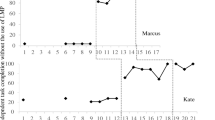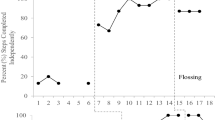Abstract
This study evaluates the impact background noise has on teaching functional skills to six adults with disabilities using video prompting. A single-subject multiple probe across behaviors with an embedded alternating treatment design was used to implement this study. Two versions of the video were created and alternated during intervention: one with significant auditory distractors, and one without. The independent variable was the iPad video prompting intervention, which involved the instruction of four functional skills. The dependent variable was the percentage of steps completed by the student correctly and independently. Tau-U effect sizes showed a large effect size for the overall VP intervention with a very small difference between conditions. All six participants showed immediate and significant growth after the video intervention. Results showed the presence of audio distractions did not affect the efficacy of the intervention.



Similar content being viewed by others
References
Allen, K. D., Burke, R. V., Howard, M. R., Wallace, D. P., & Bowen, S. L. (2012). Use of audio cuing to expand employment opportunities for adolescents with autism spectrum disorders and intellectual disabilities. Journal of Autism and Developmental Disorders, 42, 2410–2419. https://doi.org/10.1007/s10803-012-1519-7.
Ayres, K., & Cihak, D. (2010). Computer- and video-based instruction of food-preparation skills: acquisition, generalization, and maintenance. Intellectual and Developmental Disabilities, 48, 195–208. https://doi.org/10.1352/1944-7558-48.3.195.
Bellini, S., & Akullian, J. (2007). A meta-analysis of video modeling and video self-modeling interventions for children and adolescents with autism spectrum disorders. Exceptional children, 73(3), 264–287.
Bennett, K. D., Gutierrez, A., & Honsberger, T. (2013). A comparison of video prompting with and without voice-over narration on the clerical skills of adolescents with autism. Research in Autism Spectrum Disorders, 7, 1273–1281. https://doi.org/10.1016/j.rasd.2013.07.013.
Bereznak, S., Ayres, K. M., Mechling, L. C., & Alexander, J. L. (2012). Video self-prompting and mobile technology to increase daily living and vocational independence for students with autism spectrum disorders. Journal of Developmental and Physical Disabilities, 24, 269–285. https://doi.org/10.1007/s10882-012-9270-8.
Bidwell, M. A., & Rehfeldt, R. A. (2004). Using video modeling to teach a domestic skill with an embedded social skill to adults with severe mental retardation. Behavioral Interventions, 19, 263–274. https://doi.org/10.1002/bin.165.
Burke, R. V., Andersen, M. N., Bowen, S. L., Howard, M. R., & Allen, K. D. (2010). Evaluation of two instruction methods to increase employment options for young adults with autism spectrum disorders. Research in Developmental Disabilities, 31, 1223–1233. https://doi.org/10.1016/j.ridd.2010.07.023.
Cannella, H., O’Reilly, M., & Lancioni, G. (2005). Choice and preference assessment research with people with severe to profound developmental disabilities: A review of the literature. Research in Developmental Disabilities, 26, 1–15. https://doi.org/10.1016/j.ridd.2004.01.006.
Cannella-Malone, H., Sigafoos, J., O'Reilly, M., de la Cruz, B., Edrisinha, C., & Lancioni, G. E. (2006). Comparing video prompting to video modeling for teaching daily living skills to six adults with developmental disabilities. Education and Training in Developmental Disabilities, 41, 344–356.
Cannella-Malone, H. I., Fleming, C., Chung, Y.-C., Wheeler, G. M., Basbagill, A. R., & Singh, A. H. (2011). Teaching daily living skills to seven individuals with severe intellectual disabilities: acomparison of video prompting to video modeling. Journal of Positive Behavior Interventions, 13, 144–153. https://doi.org/10.1177/1098300710366593.
Cihak, D., Fahrenkrog, C., Ayres, K. M., & Smith, C. (2010). The use of video modeling via a video iPod and a system of least prompts to improve transitional behaviors for students with autism spectrum disorders in the general education classroom. Journal of Positive Behavior Interventions, 12, 103–115. https://doi.org/10.1177/1098300709332346.
Cihak, D. F., Kessler, K., & Alberto, P. A. (2008). Use of a handheld prompting system to transition independently through vocational tasks for students with moderate and severe intellectual disabilities. Education and Training in Developmental Disabilities, 43, 102–110.
Cumming, T. M., & Draper Rodríguez, C. (2017). A Meta-Analysis of Mobile Technology Supporting Individuals with Disabilities. The Journal of Special Education. doi, 0022466917713983.
Hammond, D. L., Whatley, A. D., Ayres, K. M., & Gast, D. L. (2010). Effectiveness of video modeling to teach iPod use to students with moderate intellectual disabilities. Education and Training in Autism and Developmental Disabilities, 45, 525–538.
Kellems, R. O., Frandsen, K., Hansen, B., Gabrielsen, T., Clarke, B., Simons, K., & Clements, K. (2016). Teaching multi-step math skills to adults with disabilities via video prompting. Research in Developmental Disabilities, 58, 31–44. https://doi.org/10.1016/j.ridd.2016.08.013.
Kellems, R. O., Grigal, M., Unger, D. D., Simmons, T. J., Bauder, D., & Williams, C. (2015). Technology and transition in the 21st century. Teaching Exceptional Children, 47, 336–343.
Kellems, R. O., & Morningstar, M. E. (2012). Using video modeling delivered through iPods to teach vocational tasks to young adults with autism spectrum disorders. Career Development and Transition for Exceptional Individuals, 35, 155–167. https://doi.org/10.1177/0885728812443082.
Kellems, R. O., Rickard, T. H., Okray, D. A., Sauer-Sagiv, L., & Washburn, B. (2017). iPad® video prompting to teach young adults with disabilities independent living skills: a maintenance study. Career Development and Transition for Exceptional Individuals. https://doi.org/10.1177/2165143417719078.
Kennedy, C. H. (2005). Single-case designs for educational research. Boston: Allyn and Bacon.
Kratochwill, T. R., & Levin, J. R. (2014). Single-case intervention research: methodological and statistical advances. American Psychological Association. https://doi.org/10.1037/14376-000.
Mason, R. A., Ganz, J. B., Parker, R. I., Boles, M. B., Davis, H. S., & Rispoli, M. J. (2013). Video-based modeling: differential effects due to treatment protocol. Research in Autism Spectrum Disorders, 7(1), 120–131.
Mechling, L. C., & Collins, T. S. (2012). Comparison of the effects of video models with and without verbal cueing on task completion by young adults with moderate intellectual disability. Education and Training in Autism and Developmental Disabilities, 47, 223–235.
Parker, R. I., Vannest, K. J., Davis, J. L., & Sauber, S. B. (2010). Combining nonoverlap and trend for single-case research: Tau-U. Behavior Therapy, 42, 284–299. https://doi.org/10.1016/j.beth.2010.08.006.
Rayner, C. (2011). Teaching students with autism to tie a shoelace knot using video prompting and backward chaining. Developmental Neurorehabilitation, 14, 339–347. https://doi.org/10.3109/17518423.2011.606508.
Sigafoos, J., O’Reilly, M., Cannella, H., Upadhyaya, M., Edrisinha, C., Lancioni, G. E.. ... , & Young, D. (2005). Computer-presented video prompting for teaching microwave oven use to three adults with developmental disabilities. Journal of Behavioral Education, 14, 189–201. doi: https://doi.org/10.1007/s10864-005-6297-2.
Smith, M., Ayres, K., Mechling, L., & Smith, K. (2013). Comparison of the effects of video modeling with narration vs. video modeling on the functional skill acquisition of adolescents with autism. Education and training in autism and developmental disabilities, 48, 164–178.
Walsh, E., Holloway, J., McCoy, A., & Lydon, H. (2017). Technology-aided interventions for employment skills in adults with autism spectrum disorder: a systematic review. Review Journal of Autism and Developmental Disorders, 1-14.
Wong, C., Odom, S. L., Hume, K. A., Cox, A. W., Fettig, A., Kucharczyk, S., et al. (2015). Evidence-based practices for children, youth, and young adults with autism spectrum disorder: a comprehensive review. Journal of Autism and Developmental Disorders, 45, 1951–1966. https://doi.org/10.1007/s10803-014-2351-z.
Author information
Authors and Affiliations
Contributions
RK designed and executed the study, assisted with data analyses, and contributed to the paper. CS created and analyzed the data and discussed results. BH assisted in designing the study and contributed to the paper. KF conducted the study and contributed to the paper. BC conducted the study and contributed to the paper. KS conducted the study and contributed to the paper.
Corresponding author
Ethics declarations
Conflict of Interest
The authors declare that they have no conflict of interest.
Ethics Approval
Approval was received from Brigham Young University’s IRB prior to study implementation.
Rights and permissions
About this article
Cite this article
Kellems, R.O., Sabey, C.V., Hansen, B.D. et al. Does the Noise Matter? Exploring Salient Audio Components in Video Prompting Interventions. Adv Neurodev Disord 1, 294–307 (2017). https://doi.org/10.1007/s41252-017-0036-2
Published:
Issue Date:
DOI: https://doi.org/10.1007/s41252-017-0036-2




